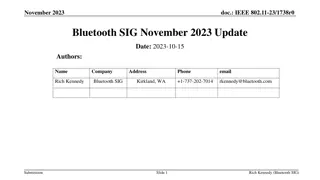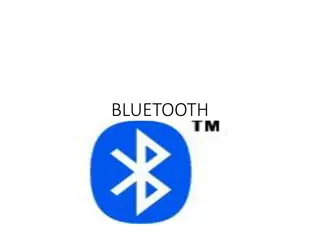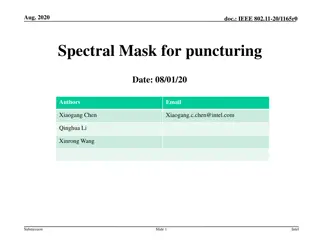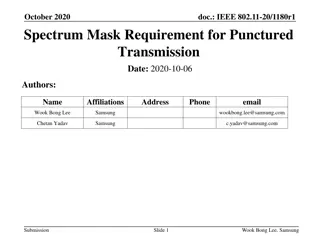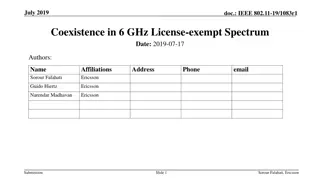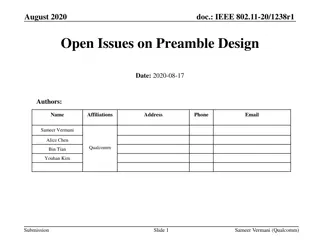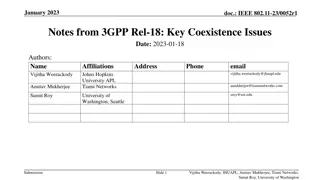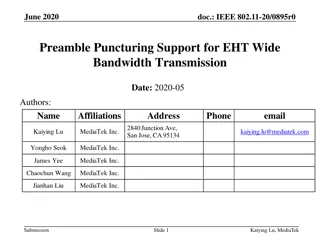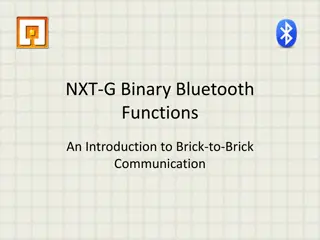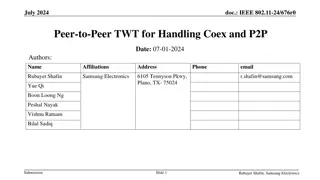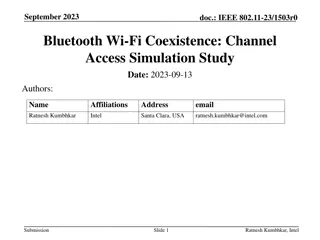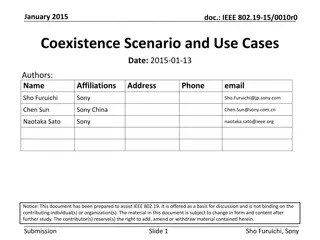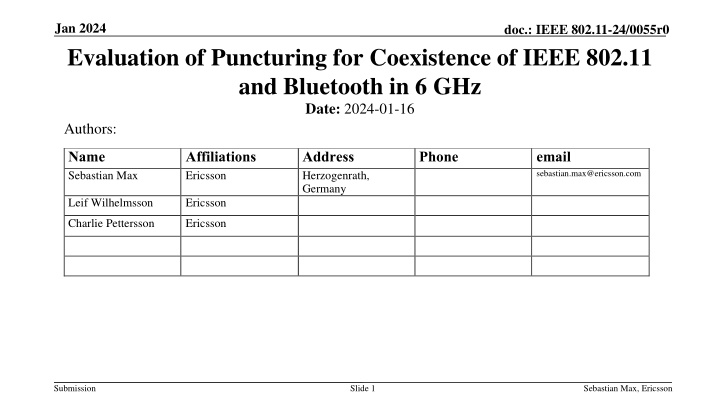
Evaluation of Puncturing for Coexistence of IEEE 802.11 and Bluetooth in 6 GHz
"Explore the evaluation of puncturing for IEEE 802.11 and Bluetooth coexistence in the 6 GHz spectrum. Assumptions, order of events on the channel, Wi-Fi puncturing techniques, and more are discussed in this document."
Download Presentation

Please find below an Image/Link to download the presentation.
The content on the website is provided AS IS for your information and personal use only. It may not be sold, licensed, or shared on other websites without obtaining consent from the author. If you encounter any issues during the download, it is possible that the publisher has removed the file from their server.
You are allowed to download the files provided on this website for personal or commercial use, subject to the condition that they are used lawfully. All files are the property of their respective owners.
The content on the website is provided AS IS for your information and personal use only. It may not be sold, licensed, or shared on other websites without obtaining consent from the author.
E N D
Presentation Transcript
Jan 2024 doc.: IEEE 802.11-24/0055r0 Evaluation of Puncturing for Coexistence of IEEE 802.11 and Bluetooth in 6 GHz Date: 2024-01-16 Authors: Name Sebastian Max Affiliations Ericsson Address Herzogenrath, Germany Phone email sebastian.max@ericsson.com Leif Wilhelmsson Ericsson Charlie Pettersson Ericsson Submission Slide 1 Sebastian Max, Ericsson
Jan 2024 doc.: IEEE 802.11-24/0055r0 Introduction Assumption 1: Bluetooth adds Listen-Before-Talk (LBT) to the channel hopping medium access Several contributions show benefit to both IEEE 802.11 and Bluetooth itself Exact details will be developed by the Bluetooth SIG Assumption 2: Bluetooth is using the complete available spectrum for the channel hopping Adaptive Frequency-Hopping (AFH) is not active / is not triggering due to low activity / has not yet converged Submission Slide 2 Sebastian Max, Ericsson
Jan 2024 doc.: IEEE 802.11-24/0055r0 Order of Events on the Channel IEEE 802.11 before Bluetooth Bluetooth before IEEE 802.11 f [MHz] f [MHz] Bluetooth LBT fails IEEE 802.11 backoff on secondary channel fails 160 160 Ack Data Data p20 p20 t t Clear Channel Assessment (CCA) result is idle on all 20 MHz subchannels IEEE 802.11 transmission starts Bluetooth hops on channel, LBT detects transmission and defers Mitigation, depending on Bluetooth LBT details Bluetooth hops on channel, LBT detects an idle channel Bluetooth transmission starts IEEE 802.11 CCA detects Bluetooth transmission and defers Bluetooth is on primary channel: anytime during backoff Bluetooth is on secondary channel: during the last 25 s of the backoff IEEE 802.11 continues to observe until the channel is idle and re-starts backoff Submission Slide 3 Sebastian Max, Ericsson
Jan 2024 doc.: IEEE 802.11-24/0055r0 Wi-Fi Puncturing: Fully Dynamic Puncturing allows 20 MHz-sized holes in the spectrum Primary 20 MHz must be idle Fully dynamic in Time: Puncturing is instantaneously, backoff simply continues Frequency: Puncture arbitrary 20 MHz-channel holes Dynamically puncture occupied channel(s) f [MHz] 160 Data ACK p20 Data ACK t Submission Slide 4 Sebastian Max, Ericsson
Jan 2024 doc.: IEEE 802.11-24/0055r0 Wi-Fi Puncturing: RU-based + Slow Adaptation f [MHz] Backoff fails Restart with 40 MHz PPDU Remember maximum PPDU width for next backoff RU-based: Puncturing reduces transmission to valid Resource Unit (RU) containing the primary 20 MHz Essentially fallback from 160 MHz to 80 MHz, 40 MHz, or 20 MHz Slow Adaptation: If non-primary 20 MHz gets busy (i and ii): Stop backoff Determine which minimum puncturing would have continued the backoff Start new backoff with punctured PPDU If primary 20 MHz gets busy (iii): Stop backoff Start new backoff with full PPDU If backoff completes (all): Start transmission, and Determine which minimum puncturing would have completed the backoff for the next PPDU 160 (i) p20 Data ACK t f [MHz] Backoff fails Restart with 40 MHz PPDU 160 Remember maximum PPDU width for next backoff (ii) p20 Data ACK t Backoff fails with p20 busy Restart on idle channel with full bandwidth f [MHz] 160 (iii) Data ACK p20 t Submission Slide 5 Sebastian Max, Ericsson
Jan 2024 doc.: IEEE 802.11-24/0055r0 Simulation Setup (same as [1]) IEEE 802.11 3 160 MHz channels Channel number 15, 47, 79 Primary 20 MHz always the 2nd 20 MHz Infinite number of 10 MB FTP file downloads KPI: File download delay (mean & 95th percentile) Bluetooth 1MHz channels with 2 MHz spacing 233 data channels Frequency hopping size randomly 44 to 94 One to six links Constant bitrate traffic 1280 B/20 ms (57 % channel occupancy) Async Connection-Oriented Link (ACL) with 10 ms connection interval Performance ignored here Slide 6 Submission Sebastian Max, Ericsson
Jan 2024 doc.: IEEE 802.11-24/0055r0 Results: FTP Download Delay median (solid) & 95-percentile (dashed) 0.5 No coexistence mechanism: Bluetooth blocks FTP downloads Bluetooth introduces LBT at the Connection Event (CE-LBT) Coexistence becomes possible CE-LBT + IEEE 802.11 adds fully dynamic puncturing Barely any impact of Bluetooth CE-LBT + IEEE 802.11 implements RU-based + slow adaptation puncturing No gain over no puncturing KPI is even slightly worse No Coex CE-LBT Puncture: Fully Dynamic Puncture: RU+Slow 0.45 0.4 0.35 FTP Download Delay [s] 0.3 0.25 0.2 0.15 0.1 0.05 0 0 1 2 3 4 5 6 Number of Bluetooth Links Submission Slide 7 Sebastian Max, Ericsson
Jan 2024 doc.: IEEE 802.11-24/0055r0 Cloud Gaming Traffic Model & KPI 4 ms 4 ms Same scenario, but FTP traffic model replaced by Downlink: XR Video Model over RTP Mean load 30 Mb/s with 10 Mb/s standard deviation 60 frames/s, every 120th frame is an I-frame (2 size) Access category video Measure frame delivery delay Uplink: Control Messages over UDP Mean size 468 B with 90 B standard deviation Mean inter-frame interval 15 ms with 6 ms standard deviation Access category voice Measure frame delivery delay KPI: Gaming delay = downlink 99-percentile + uplink 99-percentile Plot shows mean and 95-percentile gaming delay of 100 simulations Submission Slide 8 Sebastian Max, Ericsson
Jan 2024 doc.: IEEE 802.11-24/0055r0 Results: Gaming Delay median (solid) & 95-percentile (dashed) 120 No coexistence mechanism: No QoS possible Bluetooth introduces LBT at the Connection Event (CE-LBT) Coexistence becomes possible, but still significant impact CE-LBT + IEEE 802.11 adds fully dynamic puncturing Impact of Bluetooth is mitigated CE-LBT + IEEE 802.11 implements RU-based + slow adaptation puncturing Significant gain over no puncturing (p95 reduced by 20 ms) No Coex CE-LBT Puncture: Fully Dynamic Puncture: RU+Slow 100 80 Gaming Delay [ms] 60 40 20 0 0 1 2 3 4 5 6 Number of Bluetooth Links Submission Slide 9 Sebastian Max, Ericsson
Jan 2024 doc.: IEEE 802.11-24/0055r0 Results: Gaming Delay median (solid) & 95-percentile (dashed) 120 Change Assumption 2: Bluetooth is using the complete available spectrum for the channel hopping to Assumption 2: Bluetooth is using the complete available spectrum for the channel hopping With the exception of the primary 20MHz channels of the IEEE 802.11 networks CE-LBT + RU-based + slow adaptation puncturing; Bluetooth skips primary 20 channel Further improvement (~10 ms) This only has a benefit in cooperation with puncturing No Coex CE-LBT Puncture: Fully Dynamic Puncture: RU+Slow Puncture: RU+Slow & p20 100 80 Gaming Delay [ms] 60 40 20 0 0 1 2 3 4 5 6 Number of Bluetooth Links Submission Slide 10 Sebastian Max, Ericsson
Jan 2024 doc.: IEEE 802.11-24/0055r0 Conclusions Puncturing (or adaptive channel bandwidth selection) is necessary for low-latency QoS under Narrowband Frequency-Hopping (NBFH) interference Even if NBFH employs LBT Impact depends on the puncturing scheme Even a simplistic RU-based, slowly adapting scheme shows gains for latency-critical traffic Cooperation & coordination between IEEE 802.11 and Bluetooth on details can lead to further improvements For example, Bluetooth completely avoiding primary 20MHz channel in 6 GHz helps IEEE 802.11 if puncturing is employed Submission Slide 11 Sebastian Max, Ericsson
Jan 2024 doc.: IEEE 802.11-24/0055r0 References [1] Sebastian Max, IEEE 802.11 and Bluetooth Coexistence Simulations, IEEE 802.11 submission 11-23/1477r1 [2] Menzo Wentink, NBFH coexistence with Wi-Fi, IEEE 802.11 submission 11-23/1622r0 Submission Slide 12 Sebastian Max, Ericsson



